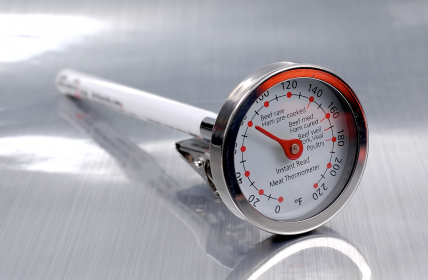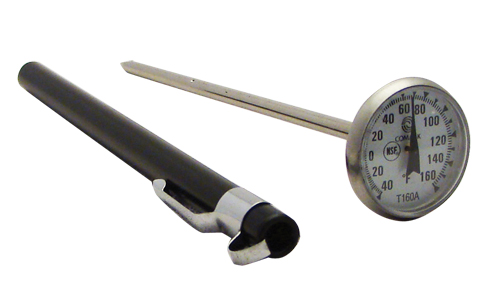 Think of a good thermometer as the crescent wrench of your food safety program. Without it, you have no idea what the temperature of your food products are, either when you cook them or when you store them. And that means you can’t tighten the bolts of your food safety program, locking out food borne illnesses and locking in food quality.
Think of a good thermometer as the crescent wrench of your food safety program. Without it, you have no idea what the temperature of your food products are, either when you cook them or when you store them. And that means you can’t tighten the bolts of your food safety program, locking out food borne illnesses and locking in food quality.
The problem with thermometers is that they lose their bearings over time and use. If you’re using that thermometer to make sure food is staying out of the danger zone, and your thermometer is more than a couple degrees Fahrenheit off, you’re taking a risk your restaurant really can’t afford. Luckily, calibrating a thermometer is easy and it should be done regularly in your restaurant.
You should re-calibrate your thermometer if:
- You dropped it (especially if it’s a dial thermometer)
- Before you use it for the first time
- If you use the same thermometer to measure very cold and very hot temperatures
- Daily or weekly if you use the same thermometer multiple times
Most health inspectors will recommend daily recalibration if you are checking many temperatures throughout the day (and hopefully, for the sake of your food safety program, you are!).
There are two methods for calibrating thermometers:
Ice point. Fill an insulated glass with crushed ice and then add a little water. Let it sit for at least five minutes and then insert the sensing part of the thermometer into the cup. Make sure the sensor is in the middle of the glass and at least an inch from the sides, bottom, and top of the glass. Hold it there for 30 seconds or until the dial stops moving or the digital thermometer beeps. Your thermometer should be reading 32 degrees Fahrenheit after 30 seconds. If it’s not, it needs to be recalibrated. The ice point method is the most accurate way to calibrate a thermometer.
Boiling point. Boil at least six inches of water. Once the water has reached a rolling boil, stick the sensor part of the thermometer into the middle of the water, taking care to keep it at least two inches from the sides, top, and bottom. After 30 seconds, the thermometer should read 212 degrees Fahrenheit if you’re at 1,000 feet or less of elevation. See below if you are at a higher altitude. If it doesn’t read 212, your thermometer needs to be recalibrated.
Changes in boiling point temperature by elevation:
- Sea Level: 212 degrees Fahrenheit
- 1,000 feet: 210 degrees Fahrenheit
- 2,000 feet: 208 degrees Fahrenheit
- 3,000 feet: 206.4 degrees Fahrenheit
- 4,000 feet: 204.5 degrees Fahrenheit
- 5,000 feet: 202.75 degrees Fahrenheit
- 8,000 feet: 197.5 degrees Fahrenheit
How To Calibrate A Thermometer
Dial thermometers have a little screw or nut that adjusts the dial to the correct temperature. Simply turn the adjuster until the dial reads the correct temperature according to the method you’re using to calibrate.
Digital thermometers have a reset button. Simply push that button when you’re at the temperature point and your thermometer is ready to go.
If you have employees who regularly take temperature readings, train them on how to calibrate thermometers correctly. Of course, simply showing an employee how to calibrate a thermometer isn’t enough to ensure calibration is happening on a regular schedule and to the correct specifications. You must trust but verify. The easiest way to do this is to schedule a time for all employees to calibrate their thermometers. That way you can ensure calibration is done regularly and accurately.
 Corner Booth Blog | TundraFMP Restaurant Supply, News & Equipment Blog
Corner Booth Blog | TundraFMP Restaurant Supply, News & Equipment Blog



